
Features
Training
Back to Basics: July 2013
In my April column, I explained how to make an enlarged opening at a second storey.
June 21, 2013
By Mark van der Feyst
In my April column, I explained how to make an enlarged opening at a second storey. This tactic can prove very useful if a mayday firefighter needs to be removed using a Stokes basket, but there is an alternative method that does not involve widening the window. This option involves using a ground ladder, a set of pulleys, a rescue rope and carabiners. A team of four RIT firefighters is required to safely carry out the operation. This technique is called the 2:1 mechanical advantage lowering system.
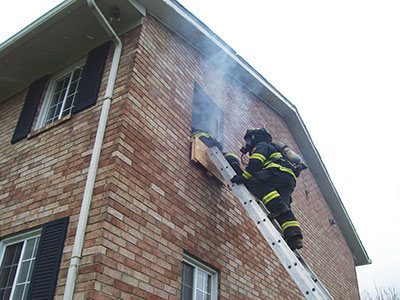 |
|
| Photo 1: When using a mechanical advantage lowering system to remove a mayday firefighter, raise and place the ladder at the bottom of the window sill. This will allow the RIT members to vent the window, enter the room and locate the mayday firefighter. |
|
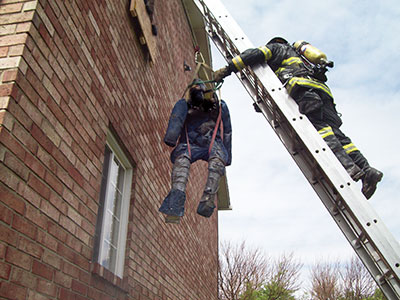 |
|
| Photo 2: A MAST device, which is a five-ring webbing sling, is used to lower the mayday firefighter. |
|
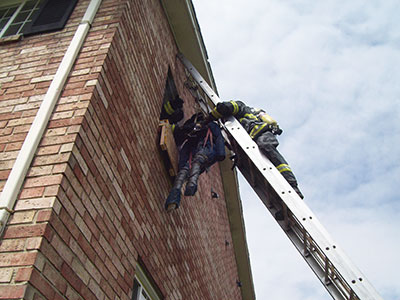 |
|
| Photo 3: The firefighter who is laddering the window should ensure that the ladder tip is above the window. This provides a high anchor point for the mechanical advantage system. |
|
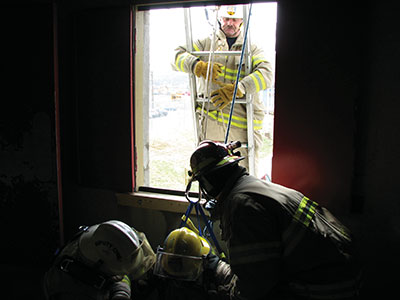 |
|
| Photo 4: When staging the mayday firefighter for removal, be sure to position his back to the window. |
|
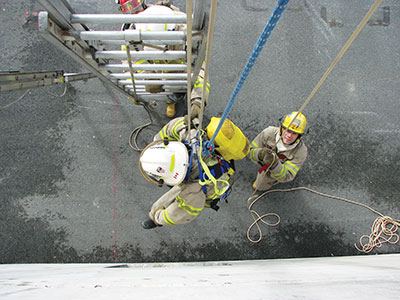 |
|
| Photo 5: The rope used to lower the mayday firefighter should be operated by the fourth member of the RIT. photos by Mark Van Der Feyst |
The idea behind this tactic is to rapidly remove the mayday firefighter through the window using basic hauling principles. Training in high-angle or rope rescue is not essential to conduct this operation. The team of four RIT firefighters should be assembled to fulfil the operation, but it can also be completed with just two firefighters if there are already two firefighters inside locating and moving the mayday firefighter to the window. The two outside RIT firefighters will help the interior team with the removal.
With a team of four RIT firefighters, two of the RIT firefighters will enter the structure using vent, enter and search tactics (see photo 1). The ground ladder is raised and placed at the bottom of the window sill, allowing the team to vent the window, enter the room and locate the mayday firefighter. This tactic works best when the location of the mayday firefighter is known to be within that room. Closing the door to the room is necessary to prevent rapid fire spread.
Once inside the room, the RIT members will search the room and locate the mayday firefighter. Once the mayday firefighter is found, the RIT members will assess and package the mayday firefighter for removal. This will involve converting the SCBA waist belt into a crude harness, using webbing to create a harness, or using a MAST device. A MAST device is a five-ring webbing sling that can be easily put around the firefighter’s legs and arms as a dragging device or for lowering the firefighter for removal. In photo 2, you can see the MAST device being used to lower the mayday firefighter. No manufacturer will recommend using the SCBA as a crude harness, but in a life-or-death situation, it will work. However, if the belt has a plastic buckle, it is wise to use another device.
The two outside RIT members will now set up the ladder so the mayday firefighter can be removed. This requires raising the ladder so that it extends above the top window sill. In photo 3, you can see the ladder tip above the window. This provides a high anchor point for the mechanical advantage system. One of the RIT members will climb the ladder with the pulley system in hand. The pulley system requires three large carabiners, two pulleys and a length of Kevlar rope. The rope needs to be a rated, life-safety rope with the ability to support one person’s weight (300 pounds). Kevlar rope is used for its high-heat and abrasion resistance. The pulley system consists of the rope being tied to a large carabiner in a figure-eight knot. Secure this first carabiner to the top rung of the ladder. Attach the second carabiner to a pulley, which should then be attached to the mayday firefighter. The third large carabiner should also be attached to a pulley, which will be secured to the second rung of the ladder. The fourth RIT member will operate the rope used to lower the mayday firefighter, as shown in photo 5.
The RIT firefighter who brings the pulley system up and secures the carabiners to the ladder will stay at the top of the ladder to help with the removal. The inside RIT members will bring the mayday firefighter to the window, prepped for removal. There are a couple of ways to stage the mayday firefighter for removal but we will look only at one of them. The mayday firefighter needs to be positioned with his back to the window, as in photo 4. Once the mayday firefighter’s upper torso is on the window sill, the second carabiner can be attached to his harness. The mayday firefighter can then be lifted using the mechanical advantage system. The two inside RIT firefighters will assist in the lift by reaching under each leg of the mayday firefighter and hoisting him up.
Once on the window sill, the RIT firefighter on the ladder can assist by grabbing the mayday firefighter’s SCBA harness and guiding him safely out, so that his body clears the window frame. The RIT firefighters’ attention needs to be focused so that the inside team is not pushing the mayday firefighter out too quickly or too forcefully, thereby causing the ladder to move away from the building. Slowly and steadily is the best way to completely clear the building. The mayday firefighter’s legs may need to be manipulated to allow for an easy transition from window sill to ladder.
Once the mayday firefighter is completely out of the building, the fourth RIT firefighter will control the mayday firefighter’s descent. As you can see in photo 5, the RIT firefighter is controlling the rope from a position that allows for a straight descent. If the RIT firefighter were farther away from the ladder, the rope would be on an angle, which would cause the load weight to transfer and make the descent a little more difficult. The mayday firefighter is guided all the way down by the RIT firefighter on the ladder as seen in photos 2, 3 and 5. The mayday firefighter can be lowered onto a waiting stretcher or Stokes basket at the bottom.
Once the mayday firefighter is out of the structure, the operation goes into reverse. The pulley system is removed, the ladder is lowered back down to the bottom of the window sill so that the inside RIT members can exit safely.
This tactic requires practice to make it an effective and efficient operation. For more information on RIT operations, see my column in the April issue of Canadian Firefighter and EMS Quarterly, available online at www.firefightingincanada.com, under Past Issues.
Mark van der Feyst is a 14-year veteran of the fire service. He works for the City of Woodstock Fire Department in Ontario. Mark instructs in Canada, the United States and India and is a local-level suppression instructor for the Pennsylvania State Fire Academy and an instructor for the Justice Institute of B.C. E-mail Mark at Mark@FireStarTraining.com
Print this page